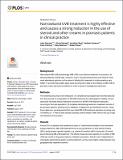Files in this item
Narrowband UVB treatment is highly effective and causes a strong reduction in the use of steroid and other creams in psoriasis patients in clinical practice
Item metadata
| dc.contributor.author | Foerster, John | |
| dc.contributor.author | Boswell, Kirsty | |
| dc.contributor.author | West, Jonathan | |
| dc.contributor.author | Cameron, Heather | |
| dc.contributor.author | Fleming, Colin | |
| dc.contributor.author | Ibbotson, Sally | |
| dc.contributor.author | Dawe, Robert | |
| dc.date.accessioned | 2019-08-13T12:30:01Z | |
| dc.date.available | 2019-08-13T12:30:01Z | |
| dc.date.issued | 2017-08-03 | |
| dc.identifier | 260534268 | |
| dc.identifier | 0b5e4956-848d-4924-9b46-82bfa2451e33 | |
| dc.identifier | 28771503 | |
| dc.identifier | 85026772325 | |
| dc.identifier.citation | Foerster , J , Boswell , K , West , J , Cameron , H , Fleming , C , Ibbotson , S & Dawe , R 2017 , ' Narrowband UVB treatment is highly effective and causes a strong reduction in the use of steroid and other creams in psoriasis patients in clinical practice ' , PLoS ONE , vol. 12 , no. 8 , e0181813 . https://doi.org/10.1371/journal.pone.0181813 | en |
| dc.identifier.issn | 1932-6203 | |
| dc.identifier.other | PubMedCentral: PMC5542593 | |
| dc.identifier.uri | https://hdl.handle.net/10023/18304 | |
| dc.description.abstract | BACKGROUND: Narrowband NB-UVB phototherapy (NB-UVB) is an effective treatment for psoriasis, as demonstrated by clinical trials. However, due to required infrastructure and need for treatment attendance opinions on the value of offering this treatment in routine practice vary. AIMS: To provide high quality large-scale and long-term data on the efficacy of NB-UVB for psoriasis under real-world conditions in order to assist in management decisions. METHODS: The following resources were employed: (1) complete and prospectively recorded prescription drug records for a population of 420,000 marked by low demographic mobility, (2) prospectively recorded clinical treatment outcomes for all NB-UVB treatment episodes occurring in the local population; (3) complete dermatology electronic treatment records of all psoriasis patients, allowing cross-validation of diagnoses and treatment records. Using these data sets, we analysed all first-ever initial NB-UVB treatment episodes occurring over 79 months (n = 1749) for both clinical outcomes and the effect of NB-UVB on the use of topical treatments for psoriasis. RESULTS: Around 75% of patients both achieved a status of "clear/minimal disease" and used fewer topical treatments. NB-UVB treatment led to a strong reduction for both steroid creams (25%) and psoriasis-specific topicals, e.g. vitamin-D products (30%) during the 12-month period following NB-UVB treatment. The effects measured were specific as no effect of NB-UVB was noted on drug prescriptions unrelated to psoriasis. Results were independent of individuals administering and/or scoring treatment, as they were highly similar between four geographically separate locations. CONCLUSIONS: NB-UVB treatment is highly effective and leads to a remarkable reduction in the need for topical cream treatments for a period of at least 12 months. | |
| dc.format.extent | 14 | |
| dc.format.extent | 3040715 | |
| dc.language.iso | eng | |
| dc.relation.ispartof | PLoS ONE | en |
| dc.subject | Adolescent | en |
| dc.subject | Adult | en |
| dc.subject | Aged | en |
| dc.subject | Aged, 80 and over | en |
| dc.subject | Child | en |
| dc.subject | Child, Preschool | en |
| dc.subject | Drug Prescriptions | en |
| dc.subject | RL Dermatology | en |
| dc.subject | RM Therapeutics. Pharmacology | en |
| dc.subject | NDAS | en |
| dc.subject.lcc | RL | en |
| dc.subject.lcc | RM | en |
| dc.title | Narrowband UVB treatment is highly effective and causes a strong reduction in the use of steroid and other creams in psoriasis patients in clinical practice | en |
| dc.type | Journal article | en |
| dc.contributor.institution | University of St Andrews. School of Medicine | en |
| dc.identifier.doi | https://doi.org/10.1371/journal.pone.0181813 | |
| dc.description.status | Peer reviewed | en |
This item appears in the following Collection(s)
Items in the St Andrews Research Repository are protected by copyright, with all rights reserved, unless otherwise indicated.

